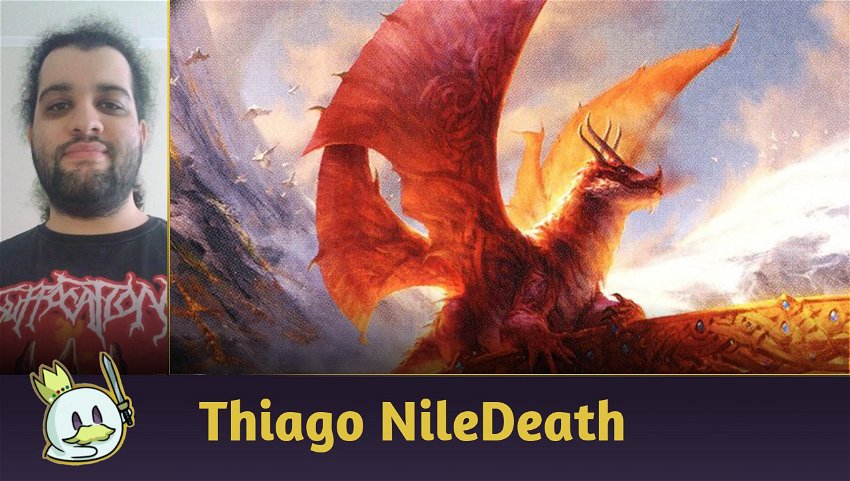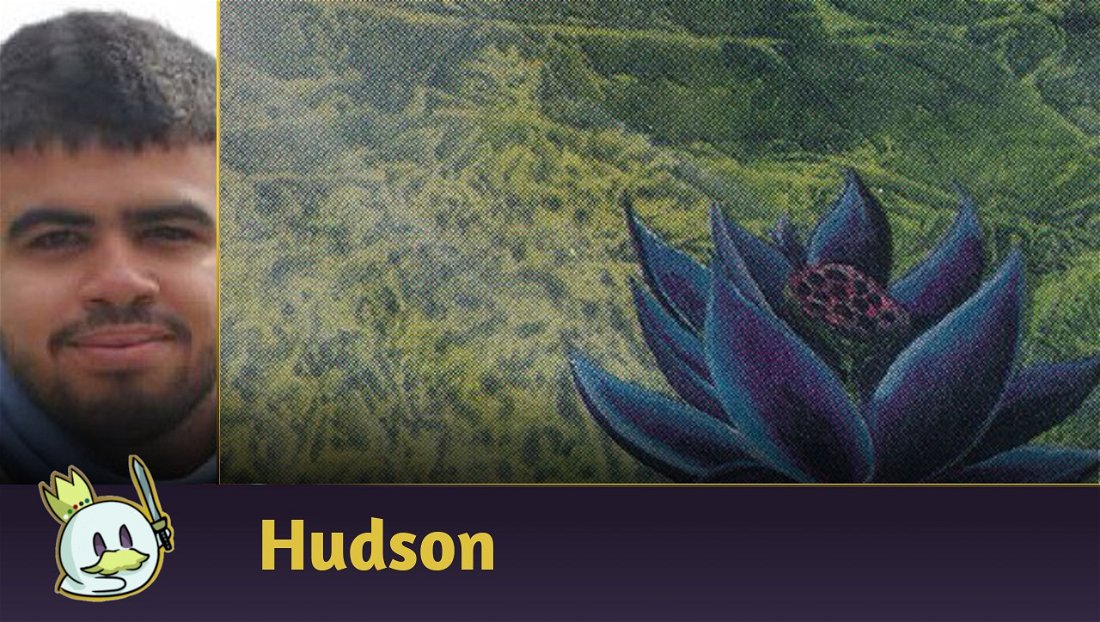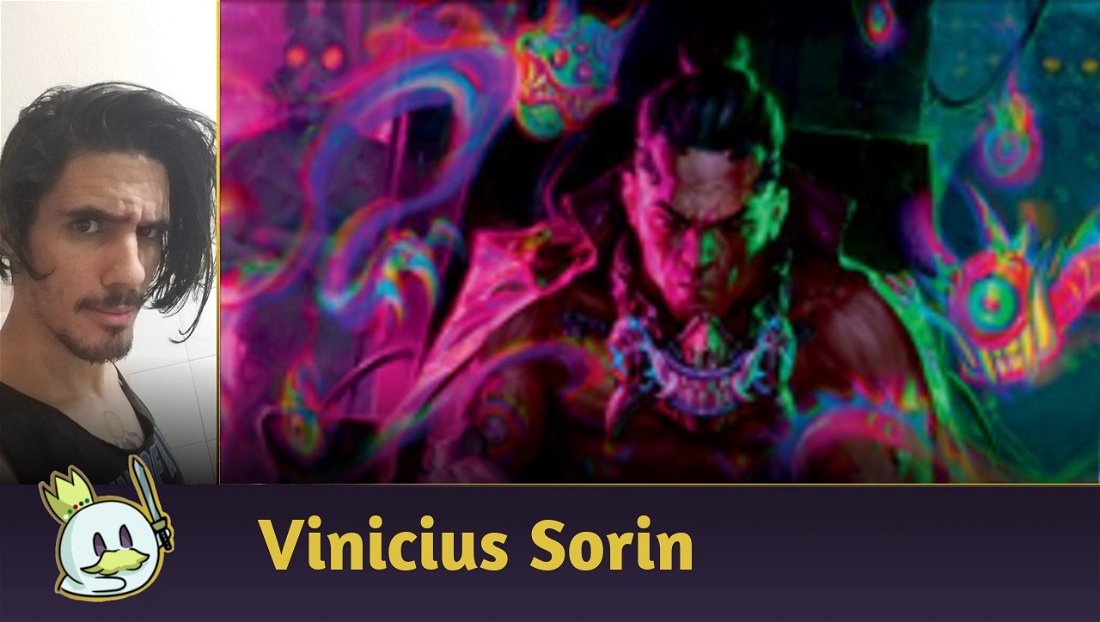2021 was a very busy year in the Magic: The Gathering world, with many new sets (plenty of them!) and more and more cards being released. In today's article, we'll recall a little of what happened in Standard this year to tinker with the format all the way to the latest digital format, Alchemy, which enters the article because it is a Standard with exclusive cards and rebalanced spells.
What was there before Kaldheim
A brief pre-Kaldheim context on the format completely plastered by Gruul Adventures being the main deck with Dimir Rogues and Rakdos Sacrifice constituting the rest of the metagame (and Mono-Red, to a lesser extent, which was a worse Gruul).
The Gruul Eldraine, which lasted an eternity in format, was the bane of many people's shoes. The deck featured the adventure package and Edgewall Innkeeper generating card advantage, as well as The Great Henge and Vivien, Monsters' Advocate for the same function. The deck's idea was to cast Lovestruck Beast or Kazandu Mammoth // Kazandu Valley on turn 3 to play The Great Henge on turn 4 and win by generating more advantage than opponents could handle. There was also the most hated artifact of recent years in Standard, Embercleave, which bypasses the combat phase dealing lethal damage out of nowhere, especially if combined with the creature with more abilities than we can remember, Questing Beast.
As this was the most popular deck and Rakdos became its main counter, The Akroan War took on more and more prominence, turning games into crazy ways. Ox of Agonas and Phoenix of Ash also became very popular due to Dimir Rogues, forcing Gruul to have at least 4 copies of these cards in total.
Speaking of Dimir Rogues, probably the most disliked deck of the format in 2021, the deck came up with Zendikar Rising that brought many cards with a thousand synergies, like the infamous Ruin Crab, also known as “Carangod”, Merfolk Windrobber, Soaring Thought-Thief and Lullmage's Domination being the main ones. Combining this mill package with Drown in the Loch and Into the Story, the best card in the deck. It also had Lurrus of the Dream-Den to get everything back from the graveyard. Rogues was strong and was probably the most difficult deck to play in the format.
With cheap spells, every turn required decisions on how to play better or how to react better, in case you were up against an aggro, and that decided whether you could beat the opponent by mill or by damage, in the case of a hand with many rogue lords.
Rakdos, in turn, were the Rogues' main counter because Kroxa, Titan of Death's Hunger, Woe Strider and Ox of Agonas together made it virtually impossible to lose to Dimir. Basically, you only needed to keep 4 lands and let your creatures go to the graveyard to escape them whenever you want.
Besides being excellent against Rogues, it was strong against Gruul thanks to its Removals + Creature Stealing + Sacrifices package. The biggest problem was when Great Circle would enter the board and untap for 2 or more turns, but Embereth Shieldbreaker and Shredded Sails were there precisely to avoid this uncomfortable situation.
Then Kaldheim Came
With Kaldheim's arrival, came many cards that dominated the format, with highlights to Esika's Chariot, Alrund's Epiphany, Faceless Haven and Goldspan Dragon (coincidentally, nerfed cards in Alchemy)).

With the snow manabase, Mono Red got stronger and there was a deck that was very disliked in the format by those who didn't play with it called Sultai Ultimatum with Emergent Ultimatum, the famous '7 mana I win' card
First, Kaldheim allowed Izzet to come back for 2 weeks and then go back to oblivion. The snow base with Frost Bite, Goldspan Dragon, Behold the Multiverse and Saw It Coming dominated the format for approximately 2 weeks until Gruul came back even stronger and became Temur with Alrund's Epiphany shortly thereafter.
Playing on the same adventure base as Gruul, but trading Embercleave for extra turns and some counterspells improved the deck, even more so with the rise of Sultai, which required timely counterspells or winning the game before seventh mana. With the rest of the dual land cycle brought in by Kaldheim, the pathways, there was a version of Gruul with Disdainful Stroke on the sideboard, an idea that became more and more popular over time as the format became Sultai vs Gruul.
Here began the Sultai's reign of terror. But it was gradual and slow (literally) because the first versions of the deck were just bad, they didn't beat aggro for being too slow and without the necessary interactions. Despite this, it was thanks to Kaldheim's payoffs and lands that the deck saw the light of day. From there, the deck became increasingly resilient and consistent, as far as possible with Yorion, Sky Nomad as a companion, and interactive to hold the game up to Ultimatum turn, that won the game.

Before going to Strixhaven, let's not forget Naya Adventures, Gruul with white to use Showdown of the Skalds, one of the strongest cards in the set until the rotation took away the adventure package. Taking advantage of the splash, Drannith Magistrate started to see play against Sultai and adventure decks. Later, Reidane, God of the Worthy would enter the deck to punish the snow manabase and Sultai.
Into the School of Mages, Strixhaven
Strixhaven was, for Standard, a weak set, but it brought staples like Elite Spellbinder and Expressive Iteration. As its impact was low on the format, I restrict myself to commenting on the few changes that have taken place in the metagame.
Here came the Gruul Magda that would become the best deck right before the rotation. Not that new cards were needed for that, but so far, there was no reason to play Gruul over Temur. This version focused on the synergy between Jaspera Sentinel and Magda, Brazen Outlaw to speed up Esika's Chariot and Goldspan Dragon, and Magda can search for them by activating her ability with 5 treasures in play:
With the spoiler given about Naya, this was the archetype most benefited from Strixhaven, inserting the world champion card in the deck. The combination of many small creatures + Toski generated an absurd and generally unavoidable advantage if you got to the point of drawing 3 or more cards with the squirrel.
Meanwhile, we had Sultai backed up with Professor Onyx and Quandrix Cultivator and Mono-White, with Elite Spellbinder. It was even the popularity of Sultai and the rise of Mono-Red that brought the white deck to the forefront. Mono-Red became stronger, with the one-drop Hall Monitor being the terror of any Elder Gargaroth who would ever block while the lizard was in play.
It's worth mentioning that the arrival of Galazeth Prismari made it possible for the Izzet Dragons base to play to this day, but only with him and Goldspan. It was more of an Izzet Tempo upgrade than an Izzet Dragons itself.
Our Adventures in the Forgotten Realms
AFR brought many new features to the format, especially for white, green and red. However, all colors have benefited greatly from the lands that transform into creatures, widely used to this day and probably until they rotate.

The cards above are some of the ones that impacted the format the most, some of them bringing decks back, like Mono-Green and Naya Winota, others, making archetypes more solid, like Sultai and Izzet.
Mono-Green became very strong with the set's two-drop that left the deck with a more robust curve. Werewolf Pack Leader dies to very few removals in turn 2 and basically doesn't have any other two-drop that blocks it well, mainly because Blizzard Brawl does the job of taking anything out of the way. Ranger Class is one of the best cards in the deck against controls and will make your creatures bigger over time, in addition to generating a huge card advantage with level 3 in late game.
One card that made a meme work for some time was The Book of Exalted Deeds. In conjunction with Faceless Haven, the Mono-White combo came out and beat aggro for 2-3 weeks, until they realized how much worse this version of Mono-White was. The deck was bad against Sultai, the most popular deck of the format, so it fell out of favor, unlike the standard Mono-White deck which featured Reidane, Magistrate and hyperlink (Paulo Vitor Damo da Rosa)'s champion card to win this match.
The biggest surprise of this block was Naya Winota who did very well in tournaments and soon became one of the best decks in the format.
With Prosperous Innkeeper and Minsc, Beloved Ranger, the most beloved card of those who like randomness over certainty, Winota, Joiner of Forces gained more consistency. With Innkeeper, it was possible to cast Chariot or Winota on turn 3 more times. Usually with Lotus Cobra and/or Jaspera Sentinel, Winota would trigger 1 or 2 times on turn 3 and win the match thereafter.
Another deck that saw a rise in this period, despite no new cards, was Temur Lukka. Basically, a Temur Adventures with Lukka, Coppercoat Outcast searching for Koma, Cosmos Serpent to win the game. I never really liked the deck, but I admit it was good because it managed to beat aggro with the Eldraine kit and the match against Sultai was a little unfavorable, but it was possible to rush damage.
At the end of this format, just before the rotation, we had a Standard that was basically Sultai Ultimatum, Gruul Magda and Winota. Luckily, Innistrad came to take Eldraine out of the picture and bring new cards.
The Midnight Hunt and Rotation
Midnight Hunt has changed the format a lot, at first, for two reasons: its power level was quite consistent with Standard and the rotation that occurred simultaneously, taking Eldraine, Theros, Ikoria and M21 out of the format.
As with every beginning of the format, there were several tests to try to find the best decks and without a doubt two cards were protagonists in the first weeks

In the beginning, it was a mistake not to play these cards and therefore a midrange, usually Bant or Sultai. There were Werewolves and Vampires tribal lists, but they didn't succeed for obvious reasons of not having enough power level.
After 3 or 4 weeks, the Izzet Dragons and Izzet Turns totally dominated the field with cards like Lier, Disciple of the Drowned, Smoldering Egg, Galvanic Iteration copyingextra turns, Burn Down the House and Fading Hope, and we saw that in the world championship won by Yuta Takahashi with Izzet Dragons.
With the format boiling down to Izzet Turns, Mono-Green to beat Izzet and Mono-White to beat the other aggro, came Crimson Vow to change absolutely nothing but make the best decks even more dominant. There's even a Mono-Black, Orzhov Control and others tier 2 or 3, but that's all.
Conclusion
As we're still living through the Crimson Vow metagame and there's been no change since Midnight Hunt, the Standard retrospective ends here. The format is unlikely to change substantially until Kamigawa comes out in February.
To finish the article, let's quickly pass through Alchemy, Magic's new digital-only format. In another articleI talk a little about the format, so, in summary, Alchemy consists of a digital-only format with exclusive cards and other rebalanced Standard cards. I like the format, despite the terrible economy to be able to play it, as it brings news to the Arena and shows that Wizards' focus is on casual and not competitive play, which was left in oblivion with the end of Rivals and Magic Pro League's professional scenario.
With its own dynamics, Alchemy has been showing a format where synergy is essential at the expense of power level, since cards can be nerfed or buffed at any time and tribal decks such as wolves, vampires and clerics seem to work well. However, like the Crimson Vow Standard that is still happening, there is no way to analyze the format much more deeply (because that is not the objective here), but I see a very broad horizon for Alchemy, so much so that the next Arena Qualifier and the Arena Open will be played on this format.
And that was the 2021 retrospective for Standard. Soon there will be a retrospective for Historic, talking about the main decks and sets that impacted it. Any questions, comments or feedback I'm available in the comments below.














— Comments 0
, Reactions 1
Be the first to comment